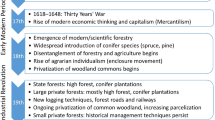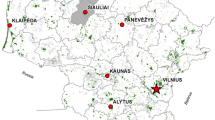Abstract
Forest management is defined mainly by the pattern of forest ownership. Thus, it is important to examine the relationships between the landscape structure of forest vegetation and the forest ownership patterns in order to understand the realities of “human impact” on cultural landscapes and ecosystems. Our study area was the mountain farm village of Hiroshima Prefecture, western Japan. These forests are owned and managed by the public, communal, or private sectors. The data set was prepared by overlapping the vegetation map data and the cadastral map data using GIS. The vegetation map was created by using ortho-rectified aerial digital photographs, and the types of vegetation were classified based on physiognomy. The cadastral map data were classified according to the ownership patterns. In the overlapping of the vegetation and cadastral maps, the boundaries between vegetation and ownership frequently conformed in the case of pine or artificial coniferous forests. Characteristic combinations of vegetation type and ownership patterns, such as pine forest and foundation or PFC and artificial coniferous forest , were also verified in terms of the proportion of vegetation type in each ownership pattern. The results suggest that the landscape patterns of strongly disturbed or commercial forests tend to be influenced by forest ownership patterns at the physiognomy level.
Access provided by CONRICYT-eBooks. Download chapter PDF
Similar content being viewed by others
1 Introduction
A forest landscape, one of the most important landscape elements of a mountainous farm village, is composed of patches that vary in size, shape, and arrangement, and influenced by not only natural site factors but also human activities (Naveh and Lieberman 1994; Turner et al. 1996; Kamada and Nakagoshi 1996, 1997). These human activities, or “management,” are explained mainly by ownership patterns (Ohmann et al. 2007) of the forests.
By recent studies, for example, relationships between ownership patterns and structure of forest landscape or vegetation have been confirmed or suggested as follows: differences of rare-species richness by public ownership of natural areas compared to private ownership in southern Ontario, Canada (Lovett-Doust et al. 2003); influence by individual landowners to littoral coarse wood density within northern Wisconsin lakes, USA (Marburg et al. 2006); differences in terms of land cover dynamics and landscape spatial pattern between community, government, and private ownership in Nepal (Nagendra et al. 2008); current patterns of vegetation cover types (Ohmann et al. 2007).
Thus, it is important to examine the relationships between the landscape structure of forest vegetation and the forest ownership patterns in order to understand the realities of “human impact” on cultural landscapes and ecosystems; moreover, this examination is also important for planning rural landscape management .
2 Study Area and Methods
2.1 Study Site
Our study area was the mountain farm village of “Yawata” in Kita-Hiroshima-cho town, Hiroshima Prefecture, western Japan (Fig. 1). Yawata is located at 650–1,200 m above sea level, and many types of vegetation such as beech climax forest, secondary forest (oak or pine), and artificial forest (cypress) are found in this region. These forests (total area of 3,500 ha) are owned and managed by the public, communal, or private sectors.
2.2 Data and Methods
The data set was prepared by overlapping the vegetation map data and the cadastral map data using the Arc GIS software (ESRI Inc.). The vegetation map data were created by using a grid cell (a total of 86,491 cells) with a size of 20 m × 20 m. The map was created by using ortho-rectified aerial digital photographs taken by Hiroshima Prefecture in 2000 (Fig. 2), and the types of vegetation were classified based on physiognomy using a grid cell: (1) deciduous broad-leaved forest (56.6%), (2) pine forest (15.4%), (3) higher artificial coniferous forest (7.5%), (4) lower artificial coniferous forest (2.5%), (5) coppice and grassland (1.5%), and others (16.5%) (Watanabe et al. 2003) (Fig. 3).
Sample of ortho-rectified aerial digital photograph plotted points of trees in each grids (Watanabe et al. 2003)
Vegetation classified map of Yamawa village (Watanabe et al. 2003)
The cadastral map (Fig. 4) data were converted from national land survey data (the National Land Agency format) to polygon line data by Hiroshima prefectural government, referred to as a “shape file” (a total of 1579 lots), and classified according to the ownership patterns: (1) private, (2) communal foundation, (3) company, (4) public, (5) public forestry corporation (PFC), and (6) other sectors. The total tendency of relationship between area and perimeter among each ownership type is linear, but some of the type (2) communal foundation appears to be relatively complicated shapes (Fig. 5).
3 Results and Discussion
In the overlapping of the vegetation and cadastral maps (Fig. 6), the boundaries between vegetation and ownership frequently conformed in the case of pine or artificial coniferous forest s.
Characteristic combinations of vegetation type and ownership type, such as pine forest and communal foundation or artificial coniferous forest and PFC, were verified (Fig. 7). The pine forest overlapped with the communal foundation was considered as originally shared meadows under strong disturbance in the age of forest resource-dependent. The combinations of the artificial coniferous forest and the PFC were attributed to the original purpose to own and manage as the commercial forests.
Using a ortho-rectified aerial digital black and white photograph taken by US military in 1947 as the scenography (the area of blue box shape in Fig. 6), the small vegetation patches (almost seemed to be deciduous broad-leaved, pine forests, and grassland) clearly match to the ownership boundary lines of almost private (Fig. 8). In those days that inhabitants depended on forest resources for daily life and agriculture , it was considered that continuous disturbance in each private forest impacted on diversity of forest landscape and stand structure.
In the limited forest areas that seemed to be complicated in combinations between the ownership types and the vegetation types such as called “Satoyama” (Duraiappah et al. 2012) based on 500 m radius from the residence areas for descriptive purpose (Table 1), most areas of the private ownerships were selected as opposed to the communal foundation, public, or PFC. The characteristic vegetation types were pine forest or grassland, but typical combinations between ownership types and vegetation types were not confirmed clearly.
4 Conclusions
The results suggest that the landscape patterns of strongly disturbed or commercial forests tend to be influenced by forest ownership patterns at the physiognomy level. These results support the theory of the ownership structure plays an important role in relation to forest management practices (Bentsen et al. 2009). Distribution of ecological communities and patterns of land ownership and use are important considerations in conservation planning for ecologically sustainable forest management (Ohmann et al. 2007).
On the other hand, there is the potential for contribution to “SATOYAMA” forest conservation by the framework methodology of community-based management (Yamaba and Nakagoshi 2000), one of commons (Ostrom 1990). Commitment to moderate utilization of secondary forests or grasslands from the community organization is often underestimated as a good case of sustainable maintenance of a rural landscape.
References
Bentsen NS, Madsen P, Ravn HP (2009) Denmark. In: Willoughby I, Balandier P, Bentsen NS, McCarthy N, Claridge J (eds) Forest vegetation management in Europe. COST Office, Brussels, pp 15–24
Duraiappah AK, Nakamura K, Takeuchi K, Watanabe M, Nishi M (eds) (2012) Satoyama-Satoumi ecosystems and human well-being. United Nations University Press, Tokyo
Kamada M, Nakagoshi N (1996) Landscape structure and the disturbance regime at three rural regions in Hiroshima Prefecture, Japan. Landsc Ecol 11:15–25
Kamada M, Nakagoshi N (1997) Influence of cultural factors on landscapes of mountainous farm villages in western Japan. Landsc Urban Plan 37:85–90
Lovett-Doust J, Biernacki M, Page R, Chan M, Natgunarajah R, Timis G (2003) Effect of land ownership and landscape-level factors on rare-species richness in natural areas of southern Ontario, Canada. Landsc Ecol 18:621–633
Marburg AE, Turner MG, Kratz TK (2006) Natural and anthropogenic variation in coarse wood among and within lakes. J Ecol 94:558–568
Nagendra H, Pareeth S, Sharma B, Schweik CM, Adhikari KR (2008) Forest fragmentation and regrowth in an institutional mosaic of community, government and private ownership in Nepal. Landsc Ecol 23:41–54
Naveh Z, Lieberman S (1994) Landscape ecology; theory and application, 2nd edn. Springer, New York
Ohmann JL, Gregory MJ, Spies TA (2007) Influence of environment, disturbance, and ownership on forest vegetation of coastal Oregon. Ecol Appl 17:18–33
Ostrom E (1990) Governing the commons. Cambridge University Press, Cambridge
Turner MG, Wear DN, Flamm RO (1996) Land ownership and land-cover change in the southern Appalachian highlands and the Olympic Peninsula. Ecol Appl 6:1150–1172
Watanabe S, Wada S, Ohtake K, Yamaba A, Shirakawa K, Nakagoshi N (2003) Vegetation map of Yawata in Geihoku Town, Hiroshima Prefecture. Nat Hist Nishi-Chugoku Mt 8:1–14 (In Japanese with English abstract)
Yamaba A, Nakagoshi N (2000) Community-based management of rural pine forests in a suburban village of Hiroshima Prefecture, western Japan. J For Res 5:237–242
Acknowledgements
I would like to thank the Kitahiroshima-cho Board of Education for allowing the cited figure data, and thank the Hiroshima prefectural government for providing analytical materials. Main part of this paper was presented in the symposium of ICLEE Congress held at Osaka, Japan, in 2006, entitled as same with this paper and was gained the Poster Award.
Author information
Authors and Affiliations
Corresponding author
Editor information
Editors and Affiliations
Rights and permissions
Copyright information
© 2017 Springer International Publishing AG, part of Springer Nature
About this chapter
Cite this chapter
Yamaba, A., Watanabe, S., Wada, S. (2017). Forest Ownership Patterns Impacting on Landscape Structure of Vegetation in a Mountainous Farm Village, Western Japan. In: Hong, SK., Nakagoshi, N. (eds) Landscape Ecology for Sustainable Society. Springer, Cham. https://doi.org/10.1007/978-3-319-74328-8_19
Download citation
DOI: https://doi.org/10.1007/978-3-319-74328-8_19
Published:
Publisher Name: Springer, Cham
Print ISBN: 978-3-319-74327-1
Online ISBN: 978-3-319-74328-8
eBook Packages: Biomedical and Life SciencesBiomedical and Life Sciences (R0)












